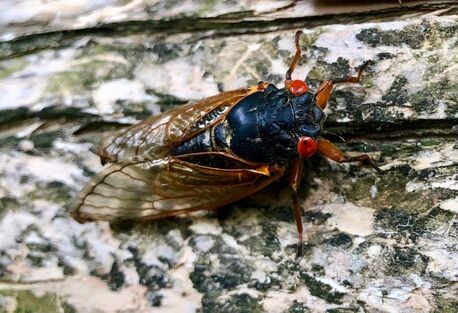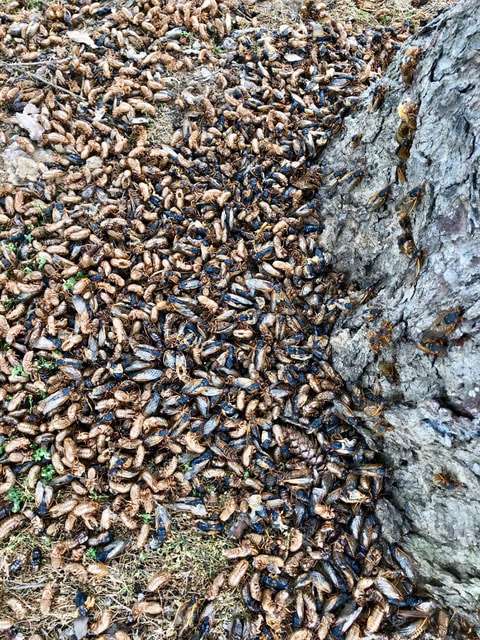 The Brood X cicada is descending on the eastern U.S., from Illinois to New York and south to Georgia. Photos by David Hoefer. The Brood X cicada is descending on the eastern U.S., from Illinois to New York and south to Georgia. Photos by David Hoefer. David Hoefer of Louisville, Ky., the co-editor of The Last Resort, examines our latest plague. If you would like to submit a post to Clearing the Fog, please contact us here. They’re here. In fact, they’re everywhere—gazillions of them. They’ve come up from holes in the ground, where they spent 17 years sucking nutrients from plant roots in the dark, biding their time until nature called them to invasion. With their cellophane wings and bulbous red eyes they look like something out of an Old Testament plague or maybe next-of-kin to the “Bug-eyed Monsters” (BEMs) that infested the covers of science-fiction pulp magazines from mid-20th century America. And the racket—an incessant loud thrumming from high in the air, as though alien spacecraft were massing behind tree cover or Saruman the White was working up his war engines, as described by Tolkien in The Lord of the Rings. Reportedly, that racket can raise noise levels in neighborhoods up to 100 decibels. What am I going on about? Why the 2021 vintage of Brood X cicadas, of course. You likely know the story by now. Brood X is number ten of 15 groups of periodical cicadas resident in eastern North America. It consists of three species and is the largest and most widespread of its kind. Brood X nymphs tunnel up from their underground lairs every 17 years, once soil temperatures reach 64 degrees Fahrenheit. They shed their exoskeletons, briefly taking on a final adult form. What follows is a furious few weeks of them discharging their Darwinian duty—flying, mating, laying eggs in the trees, and dying. And, yes, all that noisemaking—the male’s monochromatic version of a mating song. Brood X cicadas are estimated to emerge in the trillions, and species survival depends on it, because these defenseless insects make easy prey for a variety of birds and other hungry creatures (including my dog, who wolfs them down like a human chomping on potato chips—a protein supplement, I suppose). In the meantime, cicadas are as common as hydrogen, and getting into everything. You name it and they‘re on it—clothing, hair, cars, furniture, rugs, sidewalks, houses, and every other manifestation of human culture. Their weird insect noises and alien ugliness make them unwanted guests, but the fact is, unlike last year’s virus, they’re perfectly harmless. Brood X cicadas may be the ultimate proving ground for the philosophical notion of “live and let live.” Kentucky is not actually at the epicenter of Brood X, but the bugs are certainly present and accounted for in the Bluegrass State (including in great numbers in my treelined yard). Entomologists see this North American version of a locust visitation in effect until mid-July, when the survivors will begin a new 17-year cycle of root-sucking and apocalyptic emergence and transformation. The best we can do for now is batten down the hatches and learn to live with one of nature’s stranger life utterances. If you’re inclined toward more active observation, I can suggest an interesting application that is downloadable to iPhone and Android devices. Developed by an academic at Mount St. Joseph University in Cincinnati and called Cicada Safari, it enables Joe and Josephine Test-tube to take on a citizen-scientist role during the Brood X interval by documenting local cicada activity with photographs and videos and posting them to an ever-growing database curated by the application’s sponsors. I’ve enjoyed running around my neighborhood looking for interesting shots, once I got over my initial repulsion. Just remember: the cicadas probably find us at least as hideous to contemplate. AddendumThere is no mention of cicadas in The Last Resort, which makes me think that John Goodlett didn’t observe them in the Lawrenceburg environs during 1942-43. Brood X outbreaks would have occurred in 1936 and 1953, outside of the journal’s timespan. But there are other broods on different schedules, waiting for long periods to climb into the light and then share the world with us, if only briefly.
11 Comments
Tessa Hoggard
6/5/2021 06:50:46 pm
David, thanks for educating us on the amazing cicadas! Their life cycle is truly miraculous, emerging every 17 years after feasting on the nutrients of tree roots and then yielding themselves as feast to other creatures including humans! We're blessed that nature holds many lessons for us to learn. Until their next emergence from earth's vast riches, ci u later cada!
Reply
6/6/2021 09:17:24 pm
Cicada jokes? I thought there would tons of them out there by now.
Reply
Sallie Showalter
6/6/2021 11:31:59 pm
Clearly, Joan, you are stepping up to the plate in Philip's absence! Bless you, my friend. Carry on!
Reply
Joan Cullen
6/7/2021 10:45:07 pm
We were fortunate to experience Brood x this year, again, in the highlands of louisville. It could have been a once in a lifetime event back in 2004. Thankfully, I am experiencing it again. I hope to be lucky enough, next time, when I will be 83 years old.
Reply
Joe Ford
6/9/2021 11:14:23 pm
Thanks David,
Reply
Sallie Showalter
6/9/2021 11:25:32 pm
Oh, I needed a good laugh! Thank you, Joe.
Reply
Bob Patrick
6/10/2021 08:13:05 am
Thanks Sallie -- great tour through the science of Brood X. Growing up in Iowa it seemed that cicadas were with us practically every year. Recall collecting the abandoned skins from tree trunks. There are large wasps we called cicada killers (don't know the correct name) that can catch a cicada in mid flight. Pretty amazing if you happen to see it.
Reply
Joan Cullen
6/10/2021 11:22:20 pm
Dear Joe Ford,
Reply
cicada Community Union
6/12/2021 09:24:57 pm
Dear Highlands cousins,
Reply
Cicada Community Union, highlands post
6/13/2021 09:53:41 pm
We hear you! Crescent Hill, Post, or we would, if our guys would just take a break. But you know how it is. Competition is fierce. The humming of lawnmowers and weed-eaters seems irresistible to the cicaderettes.
Reply
Cicada Community Union, highlands post
6/13/2021 11:10:02 pm
We thought about calling a strike. Force folks to appreciate all we do for the environment, and what we don't do to the environment. Not a poof of additional methane gas since we don't eat anything.
Reply
Your comment will be posted after it is approved.
Leave a Reply. |
Details
Archives
June 2023
Categories
All
|



 RSS Feed
RSS Feed